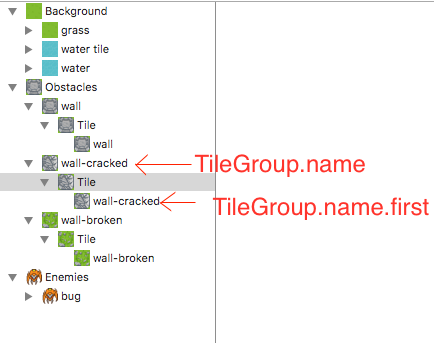Hi everyone ,
I am actually doing the tile map tutorial, I feel myself stuck with the meaning of a line in a method in the chapter 13: Intermediate Tile Maps page 364.
func tileGroupForName(tileSet: SKTileSet, name: String)
→ SKTileGroup? {
let tileGroup = tileSet.tileGroups
.filter { $0.name == name }.first
return tileGroup
}
This method returns a named tile group within a tile set to replace a tile texture.
The line I don’t understand is :
let tileGroup = tileSet.tileGroups
.filter { $0.name == name }.first
If anyone can help me pleaaaase 
@nehemie
let tileGroup = tileSet.tileGroups.filter { $0.name == name }.first
First we have tileSet.tileGroups.filter {}
Here you can specify a new array which consists of values specified within the closure.
You can experiment with this in a playground.
This more explicit code:
var array = [1, 2, 3, 4, 5, 1, 2]
let newArray = array.filter ( { value -> Bool in
value == 1
})
in a playground will result in newArray being equal to [1, 1]
In the book’s code, $0 is an inexplicit parameter. In the above code, $0 is replaced by the explicit value.
The closure should contain an expression resulting in a boolean, which indicates whether the particular value being processed should survive the filter.
$0.name == name
asks whether each name value in the array is equal to the name variable.
The book’s code doesn’t create an array though. Appended to the filter closure is .first.
That just means that the first value in the new filtered array will be used, just in case there are more of them.
I hope that helps
1 Like
Thanks Caroline for rescuing me again and sorry for the late answer, I live in Australia.
I do have some questions ,
1)Why do I have to use a filter and not just the User Data name straight away?
- Is $0.name equal to tileGroups.name ?
3)Does .first represent the first tile of my tileGroups.name filtered ?

thanks again Caroline
@nehemie - I’m usually in Australia, but am in England at the moment.
Going from the top:
Obstacles is the SKTileSet. Each SKTileSet has an array of SKTileGroups.
[wall, wall-cracked, wall-broken] is the array of SKTileGroups. Each SKTileGroup has an array of SKTileGroupRules.
[Tile] (under wall-cracked is the array of SKTileGroupRules. Each SKTileGroupRule has an array of SKTileDefinitions.
[wall-cracked] (under wall-cracked->Tile) is the array of SKTileDefinitions. A SKTileDefinition is the class that has the userData property.
So you need to go down quite a long way from the SKTileGroup to get to the userData.
tileSet.tileGroups returns [wall, wall-cracked, wall-broken], so you need to filter out wall-cracked (for example).
tileSet.tileGroups.filter {
$0.name == name
}
returns [wall-cracked] (when name == “wall-cracked”).
To get just wall-cracked, you need to get it out of the array, so first will get the first occurrence.
thank you very much for the helpful informations, I didn’t understand it was structured like that, I am going to read that chapter again 
![]()
